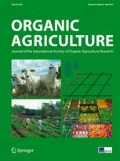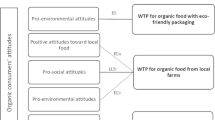Abstract
Organic food labels are promising tools to transmit the positive image of organic products to consumers. Besides health-related aspects and environmental concerns, declaration of organic quality may have a positive impact on consumers’ taste perception. Many studies have proven the positive image of organic products, but very few have considered the link between labeling a product as organic and the consumer’s evaluation of sensory quality. This paper therefore investigates how organic consumers from six European countries (Germany, France, Italy, Poland, Switzerland, and the Netherlands) are influenced by the information that strawberry yogurt is produced organically or conventionally. Within the framework of a European Union-funded research project, a cross-cultural survey with a total of N = 1,797 respondents was conducted between October 2010 and February 2011. Standardized computer-assisted interview techniques were combined with sensory tests. Results show that the presence of an organic label may lead to an enhancement of taste perception. With the exception of Italy, consumers evaluated the same product sample slightly better when an organic label was shown. For the evaluation of conventional products, the opposite effect was found for three out of six countries. These findings reveal that the positive sensory image of the organic food branch transfers to single organic products, resulting in a better taste evaluation. However, the relatively weak label effect observed in all study countries suggests that an improvement of the sensory image of organic products is advisable. This can be addressed by enhancing the sensory performance of food products as well as by implementing extensive sensory marketing activities.


Similar content being viewed by others
Notes
The phenomenon of social desirability can be described as the dishonest answer behavior in interviews, whereby the interviewees, particularly concerning sensitive topics, tend to answer questions according to what is socially correct and acceptable behavior, rather than according to fact (Fisher 1993).
It should be noted, that the term “conventional” is used for the strawberry yogurt sample with added aroma, although it is technically of organic quality.
References
Agence Bio (2012) La marque AB. http://www.agencebio.org/pageEdito.asp?IDPAGE=36&n3=74. Accessed 26 Apr 2012
Annett LE, Muralidharan V, Boxall PC, Cash SB, Wismer WV (2008) Influence of health and environmental information on hedonic evaluation of organic and conventional bread. J Food Sci 73(4):50–57
Asioli D, Pignatti E, Canavari M (2012) Sensory attributes and marketing: an exploration of Italian organic producers’ perspective. Die Bodenkultur J Land Manag Food Env 63(2–3):7–16
Asioli D, Pignatti E, Canavari M, Obermowe T, Sidali KL, Vogt C, Spiller A (2013) Sensory experiences and expectations of Italian and German organic consumers. J Int Food and Agribusiness Marketing (in press)
Baltas G (2001) Nutrition labelling: issues and policies. Eur J Mark 35(5/6):708–721
Bär, T (2007) Ökologischer Landbau in Polen. Institutionen als Entwicklungsfaktoren. In: Forschungspapiere “Probleme der Öffentlichen Verwaltung in Mittel- und Osteuropa”. http://opus.kobv.de/ubp/volltexte/2007/1546/pdf/fopap10.pdf. Accessed 18 February 2013
Baranek E (2007) Wer kauft Bio? Zielgruppenspezifische Motive für den Kauf von Biolebensmitteln, Berlin
Bijoor H (2006) A case for internal branding. Financial express. http://www.financialexpress.com/news/a-case-for-internal-branding-/95393/0. Accessed 20 February 2013
Bio-Suisse (2012) http://www.bio-suisse.ch/en/whoisbiosuisse.php. Accessed 6 Sept 2012
Block LG, Perrachio LA (2006) The calcium quandary: how consumers use nutrition labels. J Public Pol Mar 25(2):188–196
BMELV (2012) Das staatliche Bio-Siegel. http://www.bmelv.de/SharedDocs/Standardartikel/Landwirtschaft/Oekolandbau/Bio-Siegel.html. Accessed 6 Sept 2012
Bortz J, Schuster C (2010) Statistik für Human- und Sozialwissenschaftler. Springer, Berlin
Canavari M, Olson KD (2007) Organic food. Consumers' choices and farmers' opportunities. Springer, New York
Canavari M, Asioli D, Bendini A, Cantore N, Gallina Toschi T, Spiller A, Obermowe T, Buchecker K, Lohmann M (2009) Summary report on sensory-related socio-economic and sensory science literature about organic food products. Deliverable No. 1.2 of EU Project Ecropolis. http://orgprints.org/17208/2/deliverable_1_2_sensory_literature.pdf. Accessed 18 Feb 2013
Capretta PJ, Moore MJ, Rossiter TR (1973) Establishment and modification of food and taste preferences: effects of experience. J Gen Psychol 89(1):27–46
Carpenter M, Larceneux F (2008) Label equity and the effectiveness of values-based labels: an experiment with two French Protected Geographic Indication labels. Int J Consum Stud 32(5):499–507
Chinnici G, D'Amico M, Pecorino B (2002) A multivariate statistical analysis on the consumers of organic products. Brit Food J 104(3):187–199
Defrancesco E, Rossetto L (2007) From niche to market: the growth of organic business in Italy. In: Canavari M, Olson KD (eds) Organic food. Consumers' choices and farmers' opportunities. Springer, New York, pp 3–16
Dimitri C, Oberholtzer L (2005) Market-led growth vs. government-facilitated growth: development of the U.S. and EU Organic Agricultural Sectors, Washington D.C.
European Union (1991) Council Regulation (EEC) no 2092/91 of 24 June 1991 on organic production of agricultural products and indications referring thereto on agricultural products and foodstuffs. http://eur-lex.europa.eu/LexUriServ/LexUriServ.do?uri=CONSLEG:1991R2092:20080514:EN:PDF. Accessed 9 Jan 2013
European Union (2007) Council Regulation (EU) No 834/2007 of 28 June 2007 on organic production and labelling of organic products and repealing Regulation (EEC) No 2092/91. Official Journal of the European Union, L 189 (20.07.2007), pp 1–23
European Union (2010) Commission regulation (EU) no 271/2010 of 24 March 2010 amending regulation (EC) no 889/2008 laying down detailed rules for the implementation of Council Regulation (EC) no 834/2007, as regards the organic production logo of the European Union. Official Journal of the European Union, L 84 (31.03.2010), pp 19–22
European Union (2011) Council Regulation (EU) no 1169/2011 of the European Parliament and of the Council of 25 October 2011 on the provision of food information to consumers, amending Regulations (EC) no 1924/2006 and (EC) no 1925/2006 of the European Parliament and of the Council, and repealing Commission Directive 87/250/EEC, Council Directive 90/496/EEC, Commission Directive 1999/10/EC, Directive 2000/13/EC of the European Parliament and of the Council, Commission Directives 2002/67/EC and 2008/5/EC and Commission Regulation (EC) No 608/2004. Official Journal of the European Union, L 304 (22.11.2011), pp 18–63
Festinger L (1957) A theory of cognitive dissonance. Stanford University Press, Stanford
Fillion L, Arazi S (2002) Does organic food taste better? A claim substantiation approach. Nutr Food Sci 32(4):153–157
Fisher RJ (1993) Social desirability bias and the validity of indirect questioning. J Consum Res 20(2):303–315
Grebitus C, Yue C, Bruhn M, Jensen HH (2007) What affects consumption patterns of organic and conventional products? Poster paper presented at the American Agricultural Economics Association Annual Meeting 2007, Portland
Guion DT, Stanton JV (2012) Advertising the U.S. national organic standard: a well-intentioned cue lost in the shuffle? J Promot Manag 18(4):514–535
Hadary G (1945) The use of taste response tests in market research. J Mark 10(2):152–155
Hair JF, Black WC, Babin BJ, Anderson RE (2010) Multivariate data analysis. A global perspective. Pearson, Upper Saddle River
Hamm U, Gronefeld F (2004) The European market for organic food: revised and updated analysis. School of Management and Business, University of Wales, Aberystwyth
Hill H, Lynchehaun F (2002) Organic milk: attitudes and consumption patterns. Brit Food J 104(7):526–542
Hughner RES, Mcdonagh P, Prothero A, Shultz CJ, Stanton J (2007) Who are organic food consumers? A compilation and review of why people purchase organic food. J Consum Behav 6(2–3):94–110
Hui YH (2010) Handbook of fruit and vegetable flavors. Wiley, Hoboken
Idda L, Madau FA, Pulina P (2008) The motivational profile of organic food consumers: a survey of specialized stores customers in Italy. Paper presented at the EAAE Congress 2008, 26–29th of August, Ghent.
Janssen M, Hamm U (2011) Consumer perception of different organic certification schemes in five European countries. Org Agric 1(1):31–43
Knoblich H, Fries A (1996) Geschmacksstoffe als Elemente der Produktgestaltung. In: Knoblich H, Scharf A, Schubert B (eds) Geschmacksforschung. Marketing und Sensorik für Nahrungs- und Genußmittel. Oldenbourg, München, pp 59–87
Kuhnert H, Feindt PH, Wragge S, Beusmann V (2003) Nachfrage nach Öko-Lebensmitteln: Veränderung durch BSE?. In: Ökologie & Landbau. Jahrbuch Öko-Landbau 125(1): 29–32
Latour KA, Latour MS (2010) Bridging aficionados’ perceptual and conceptual knowledge to enhance how they learn from experience. J Consum Res 37(4):688–697
Lawless HT, Heymann H (2010) Sensory evaluation of food: principles and practices. Springer, New York
Leuthesser L, Kohli CS, Harich KR (1995) Brand equity: the halo effect measure. Europ J Market 29(4):57–66
Maciejczak M (2009) Comparative report about information from supply chain actors. Deliverable no. 4.1 of Ecropolis Project. http://osis.ecropolis.eu/fileadmin/documents/level3/Ecropolis_id350_ComparativeReportInfoSupplyChain.pdf. Accessed 18 Feb 2013
McEachern MG, Warnaby G (2008) Exploring the relationship between consumer knowledge and purchase behaviour of value-based labels. Int J Consum Stud 32(5):414–426
Meiselman HL (1993) Critical evaluation of sensory techniques. Food Qual Prefer 4:33–40
Ministry for Food, Agriculture and Fisheries (2009). http://organicrules.org/1962/. Accessed 6 Nov 2012
Napolitano F, Braghieri A, Piasentier E, Favotto S, Naspetti S, Zanoli R (2010) Cheese liking and consumer willingness to pay as affected by information about organic production. J Dairy Res 77:280–286
Obermowe T, Sidali KL, Hemmerling S, Busch G, Spiller A (2011) Sensory- based target groups for the organic food market—comparative report from quantitative consumer research. Deliverable no. 4.3 of Ecropolis Project. http://www.ecropolis.eu/images/downloads/deliverable%204.3%20target%20groups.pdf. Accessed 18 February 2013
ÖkoKennzG (2001) Gesetz zur Einführung und Verwendung eines Kennzeichens für Erzeugnisse des ökologischen Landbaus (Öko-Kennzeichengesetz—ÖkoKennzG)
Padel S, Midmore P (2005) The development of the European market for organic products: insights from a Delphi study. Brit Food J 107(8):626–646
Plaßmann S, Hamm U (2009) Kaufbarriere Preis?—Analyse von Zahlungsbereitschaft und Kaufverhalten bei Öko-Lebensmitteln. Final report of BÖL-project 06OE119. http://orgprints.org/15745/1/15745-06OE119-uni_kassel-hamm-2009-kaufbarriere_preis.pdf. Accessed 18 Feb 2013
Schifferstein HNJ, Oude Ophuis PAM (1998) Health-related determinants of organic food consumption in The Netherlands. Food Qual Prefer 9(3):119–133
Scholderer J, Nielsen NA, Bredahl L, Claudi-Magnussen C, Lindahl G (2004) Organic pork: consumer quality perceptions. Project paper no 02/04, Aarhus
Schubert B, Godersky C (1996) Entstehung von Geschmackspräferenzen. In: Knoblich H, Scharf A, Schubert B (eds) Geschmacksforschung. Marketing und Sensorik für Nahrungs- und Genussmittel. Oldenbourg, München, pp 89–129
Scintu MF, Del Caro A, Urgeghe P, Piga C, Di Salvo R (2010) Sensory profile development for an Italian PDO ewe's milk cheese at two different ripening times. J Sens Stud 25:577–590
Sinesio F, Comendador FJ, Peparaio M, Moneta E (2009) Taste perception of umami-rich dishes in Italian culinary tradition. J Sens Stud 24:554–580
Skal (2012) http://www.skal.nl/English/EKOQualitymark/tabid/109/language/nl-NL/Default.aspx. Accessed 6 Nov 2012
Skal (2012a) http://www.skal.nl/LinkClick.aspx?fileticket=JzvpQz6YeKc%3d&tabid=112. Accessed 18 Feb 2013
Stenzel WR (2008) Wie schmeckt Bio? In: Hildebrandt G (ed) Geschmackswelten: Grundlagen der Lebensmittelsensorik. DLG, Frankfurt am Main, pp 189–195
Stolz H, Bodini A, Stolze M, Hamm U, Richter T (2009) Lebensmittelqualität aus der Verbraucherperspektive—eine Synthese qualitativer Studien zur Wahrnehmung und Beurteilung verschiedener Qualitätskriterien bei Öko-Produkten. Ber über Landwirtsch 87(1):153–182
Stolz H, Jahrl I, Baumgart L, Schneider F (2010) Sensory experiences and expectations of organic food. Results of focus group discussions. Deliverable no. 4.2 of Ecropolis Project. http://www.ecropolis.eu/downloads/deliverable_4_2_consumer_research.pdf. Accessed 18 Feb 2013
Teisl MF, Roe B (1998) The economics of labeling: an overview of issues for health and environmental disclosure. Agric Resour Econ Rev 27(2):140–150
Thøgersen J (2000) Psychological determinants of paying attention to eco-labels in purchase decisions: model development and multinational validation. J Consum Pol 23(3):285–313
Verlegh PWJ, Steenkamp JBEM (1999) A review and meta-analysis of country-of-origin research. J Econ Psychol 20:521–546
Villiger A (2000) Jenseits der Öko-Nische in der Lebensmittelbranche. In: Villiger A, Wüstenhagen R, Meyer A (eds) Jenseits der Öko-Nische. Birkhäuser, Basel, pp 57–140
Ward RW, Jauregui CE (2006) Do consumers really use food labels? Paper presented at the American Agricultural Economics Association Conference, 23–26th of July 2006, Long Beach
Wills JM, Schmidt DB, Pillo-Blocka F, Cairns G (2009) Exploring global consumer attitudes toward nutrition information on food labels. Nutr Rev 67(1):102–106
Zanoli R, Naspetti S (2002) Consumer motivations in the purchase of organic food: a means–end approach. Brit Food J 104(8):643–653
Acknowledgments
This article was produced with financial support from the Commission of the European Community under the 7th Framework Programme. We would like to thank all project research partners that participated in this article as well as the experts of the SME association, which supported the work.
Author information
Authors and Affiliations
Corresponding author
Rights and permissions
About this article
Cite this article
Hemmerling, S., Obermowe, T., Canavari, M. et al. Organic food labels as a signal of sensory quality—insights from a cross-cultural consumer survey. Org. Agr. 3, 57–69 (2013). https://doi.org/10.1007/s13165-013-0046-y
Received:
Accepted:
Published:
Issue Date:
DOI: https://doi.org/10.1007/s13165-013-0046-y




